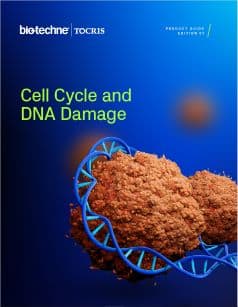p53
p53 (TP53) is a transcription factor whose protein levels and post-translational modification state alter in response to cellular stress (e.g. hypoxia, DNA and spindle damage). Activation of p53 occurs by several mechanisms including phosphorylation by ATM, ATR, Chk1 and MAPKs.
p53 Inhibitors |
|
|---|---|
| Cat. No. | Product Name / Activity |
| 4924 | CEP 1347 |
| MDM4 inhibitor; inhibitor of JNK signaling | |
| 1267 | Pifithrin-α hydrobromide |
| p53 inhibitor. Also aryl hydrocarbon receptor agonist | |
| 3843 | Cyclic Pifithrin-α hydrobromide |
| p53 inhibitor | |
| 2653 | Pifithrin-μ |
| Inhibitor of p53-mitochondrial binding | |
p53 Activators |
|
| Cat. No. | Product Name / Activity |
| 3503 | HLI 373 |
| Hdm2 inhibitor; activates p53-dependent transcription | |
| 6904 | Idasanutlin |
| Potent MDM2 inhibitor; inhibits MDM2-p53 interaction | |
| 3984 | Nutlin-3 |
| MDM2 antagonist; inhibits MDM2-p53 interaction | |
| 6075 | Nutlin 3a |
| MDM2 antagonist; active enantiomer of Nutlin-3 (Cat. No. 3984) | |
| 2443 | RITA |
| p53-MDM2 interaction inhibitor; antitumor | |
| 5332 | SP 141 |
| High affinity MDM2 inhibitor | |
Other |
|
| Cat. No. | Product Name / Activity |
| 5417 | BMH 21 |
| p53 pathway activator; also RNA polymerase 1 inhibitor | |
| 3362 | MIRA-1 |
| Restores mutant p53 activity; proapoptotic | |
| 3710 | PRIMA-1MET |
| Restores mutant p53 activity | |
p53 (aka TP53) is a transcription factor whose protein levels and post-translational modification state alter in response to cellular stress (such as DNA damage, hypoxia and spindle damage). Activation of p53 begins through a number of mechanisms including phosphorylation by ATM, ATR, Chk1 and MAPKs. MDM2 is a ubiquitin ligase that binds p53 and targets p53 for proteasomal degradation.
Phosphorylation, p14ARF and USP7 prevent MDM2-p53 interactions, leading to an increase in stable p53 tetramers in the cytoplasm. Further modifications such as methylation and acetylation lead to an increase in p53 binding to gene specific response elements. p53 regulates a large number of genes (>100 genes) that control a number of key tumor suppressing functions such as cell cycle arrest, DNA repair, senescence and apoptosis. Whilst the activation of p53 often leads to apoptosis, p53 inactivation facilitates tumor progression; inactivating p53 mutations occur in over 50% of cancers.
Literature for p53
Tocris offers the following scientific literature for p53 to showcase our products. We invite you to request* your copy today!
*Please note that Tocris will only send literature to established scientific business / institute addresses.
Cell Cycle and DNA Damage Research Product Guide
This product guide provides a review of the cell cycle and DNA damage research area and lists over 150 products, including research tools for:
- Cell Cycle and Mitosis
- DNA Damage Repair
- Targeted Protein Degradation
- Ubiquitin Proteasome Pathway
- Chemotherapy Targets
Cell Cycle & DNA Damage Repair Poster
In normal cells, each stage of the cell cycle is tightly regulated, however in cancer cells many genes and proteins that are involved in the regulation of the cell cycle are mutated or over expressed. This poster summarizes the stages of the cell cycle and DNA repair. It also highlights strategies for enhancing replicative stress in cancer cells to force mitotic catastrophe and cell death.


